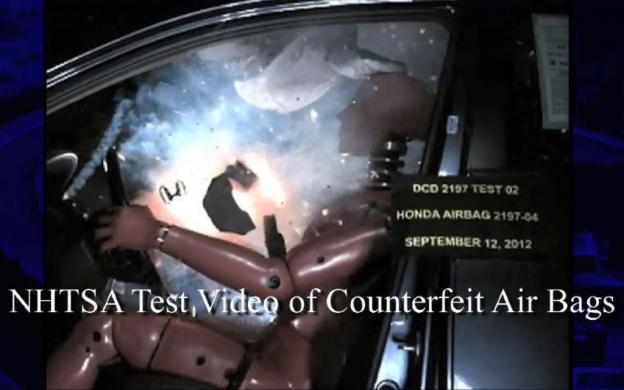 The National Highway Traffic Safety Administration (NHTSA) has issued a consumer safety advisory regarding counterfeit airbags. These airbags, which the NHTSA says are installed at third party repair shops, can malfunction and jeopardize the lives of vehicle occupants in a crash.
The National Highway Traffic Safety Administration (NHTSA) has issued a consumer safety advisory regarding counterfeit airbags. These airbags, which the NHTSA says are installed at third party repair shops, can malfunction and jeopardize the lives of vehicle occupants in a crash.
According to the NHTSA, car owners who have been in a crash may have had their airbags replaced with counterfeits. The counterfeit parts look like original equipment, right down to fake manufacturer logos.
However, the counterfeit airbags are not made to the same standards as genuine parts, and have consistently malfunctioned in tests. In a crash, these fake airbags may not deploy, or they may expel metal shrapnel if they do. In one test, an airbag separated from its mounting point, showering the vehicle occupants with sparks from the bag’s pyrotechnics.
While it does not know the full scope of the problem, at the moment the NHTSA estimates that a very small number (0.1 percent) of American vehicles have counterfeit airbags. The NHTSA is not aware of any deaths or injuries due to counterfeit airbags.
The NHTSA is urging consumers whose vehicle has been in a crash within the last three years, and who have had the airbags replaced by a shop that is not part of a new car dealership, to call the manufacturer and have the replacement parts inspected. The safety advisory also applies to anyone who bought a replacement airbag online.
If the manufacturer finds a counterfeit airbag, vehicle owners will need to have it replaced at their own expense.
Consumers who purchased their cars new and have not been in a crash, and people who own a used car that has not had its airbags replaced in the last three years, shouldn’t have anything to worry about.
So far, the NHTSA is aware of counterfeit airbags being made for the following makes and models:
Acura: 2009-2011 TSX
Audi: 2006-2009 A3, A4, A6, A8, Q5, Q7
BMW: 2004-2011 5 Series; 2007-2011 3 Series, X5; 2011-2012 X3
Buick: 2010-2011 Lacrosse
Chevrolet: 2011-2012 Cruze, Volt; 2006-2010 Aveo; 2012 Camaro
Ford: 2012 Focus; 2005-2009 Mustang
Honda: 2003-2012 Accord; 2006-2011 Civic; 2002-2011 CRV; 2007-2011 Fit; 2009-2011 Pilot, Insight; 2010-2011 Crosstour; 2011 Odyssey
Hyundai: 2007-2011 Elantra; (not listed) Genesis, Sonata
Infiniti: 2007-2011 G35/37, EX35
Kia: 2010-2011 Soul, Forte; 2004-2009 Spectra
Land Rover: 2012 Range Rover Evoque
Lexus: 2006-2011 IS; 2003-2008 GX470; 2007-2009 RX350; (not listed) ES350
Mazda: 2004, 2010-2012 Mazda3
Mercedes: 2009-2011 C-Class, GLK; 2010-2011 E-Class; 2007-2008 S550; 2006-2010 ML; 2009-2010 GL
Mitsubishi: (not listed) Outlander
Nissan: 1992-2002, Quest; 2010-2011 Quest; 2009-2011 Cube; 2007-2011 Versa; 2009-2010 Murano; (not listed) Altima
Subaru: 2008-2009 Forester, Impreza, Outback; 2010-2011 Legacy
Suzuki: 2007-2010 SX4
Toyota: 2002-2006, 2012 Camry; 2009-2011 Corolla, Matrix; 2007-2011 Yaris, Tundra; 2004-2011 Highlander, Sienna, Tacoma; 2010-2012 Prius; 2003-2006 Tundra, Sequoia; 2003-2010 Land Cruiser; 2004-2010 Highlander; 2004-2009 4Runner; 2007-2009 Solara; 2005-2011 RAV4
Volkswagen: 2006-2010 Jetta
Volvo: (not listed) XC60, XC70, V70, S60, S80
The NHTSA is advising all consumers, even ones whose cars do not appear on this list, to have their vehicles inspected if their airbags have been replaced in the last three years. In addition, a vehicle may not have counterfeit airbags just because it is on this list, it just means the NHTSA has found counterfeits made for that model. A full list of manufacturer call centers is available at the NHTSA’s website.
Editors' Recommendations
- April’s solar eclipse may produce an unexpected consequence
- Honda’s new airbag functions like a baseball catcher’s mitt


